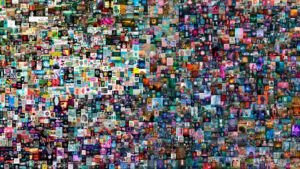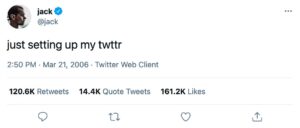The recent spike in the popularity of non-fungible tokens (‘NFTs’) has been tagged by some as the future of the digital art market, and has the markings of the next big cryptocurrency tidal wave. The commercial and sociological effect of NFTs is intriguing, and yet they also mint a series of equally interesting legal and regulatory challenges. We discuss some of these challenges below.
NFTs stands for ‘non-fungible tokens’, meaning that they are not a mutually interchangeable currency. Unlike cash or cryptocurrency, whereby one coin can be traded for another of the same value, each NFT is unique and cannot be exchanged for another. This unique digital asset can be any digital file, including artwork, music, videos and social media posts, however much of the excitement around NFTs is from trading digital art.
Each NFT utilises blockchain technology to verify ownership of a digital asset. ERC-721 (the “Non Fungible Token Standard”) is an open standard that represents NFTs on the Ethereum blockchain; it ensures absolute certainty over ownership and usage of a digital asset, making ERC-721 tokens unique.
One striking example of a commercially successful NFT is ‘Everydays – the First 5000 Days’ by digital artist Mike Winkelmann, which sold for USD$69 million earlier this year.

A blockchain is a decentralised digital database that keeps a publicly accessible ledger which records ownership of digital files. It is the record-keeping technology behind most cryptocurrency systems. Its decentralised nature means the network is very difficult to hack, copy, or defraud which means that the NFT is impossible to forge or steal.
To create (or ‘mint’) an NFT, a digital file is uploaded to an NFT auction market. This creates a copy of the file, which is recorded as an NFT and stored as an entry, or ‘block’, in a timeline of data, or ‘chain’, on the blockchain. The NFT can then be bought and sold using cryptocurrency. Most NFTs are stored on the Ethereum blockchain, although other blockchains can create their own versions of NFTs.
A blockchain does not require an external authority to validate its authenticity and integrity. It has been described by blockchain experts Don and Alex Tapscott as “an incorruptible digital ledger of economic transactions that can be programmed to record not only financial transactions but virtually everything of value”.
The central concept of NFTs is that they provide a way to record agreed-upon value and ownership of digital assets. When an NFT is minted, the original creator of the digital work retains the copyright and reproduction rights over the work. When the NFT is purchased, the buyer gains the right to use the copyrighted work for personal consumption, as well as the ‘pride of ownership’ of the NFT. In most cases, the buyer does not become a holder of copyright, and usually cannot make commercial use of the digital work other than by reselling the NFT.
In this sense, typical NFTs do not grant different rights to rights that are typically granted to any purchaser of ‘traditional’ artworks.
Since the work remains online, other internet users can usually see, download or screenshot it. Whilst anyone can typically view the digital work, possession of the NFT provides the owner a highly evolved and sophisticated digital certificate of title. And therein lies the value of the NFT.
For example, Twitter founder Jack Dorsey recently auctioned the very first published tweet (from 21 March 2006) as an NFT for USD$2.9 million. The tweet remains on Twitter and can be viewed by anyone, but minting an NFT from the tweet turned it into an asset able to be bought and sold.

In some marketplaces there may be terms attached to the sale of an NFT which grant the buyer additional rights over the work. For example, Cryptokitties, a platform used to buy and sell digital cats, permits commercial use of the purchased NFT up to USD$100,000 per year.
NFTs can function as speculative assets. Like physical art, an NFT can be purchased in the hope that the value will increase so that it can be resold for a profit. At present, the total NFT market is valued at USD$250 (AUD$325) million. [1]
As NFTs are a fairly new technology experiencing a sudden spike in popularity, it is uncertain how they fit into the legal frameworks that regulate the cryptocurrency, finance and technology industries.
One particular grey area is under what circumstances a crypto token such as an NFT should be regulated as a financial product by ASIC, and subject to applicable laws including the Corporations Act 2001 (Cth).
NFTs have additional potential applications. For example, they could be used as security instruments to guarantee repayments of loans or account receivables. Further, as NFTs are unique, they can be used for digital identification purposes. That is, to guarantee the authenticity not only of a good or service, but potentially any person.
Where copyright subsists in the digital asset that is traded as an NFT (e.g. as an artistic work) under the Copyright Act 1968 (Cth) (‘Copyright Act’), the individual who purchases the NFT is not granted any copyright ownership of the digital asset. The copyright ownership remains with the creator of the work, much like an art collector who purchases a painting. However, it may be possible to buy the commercialisation rights or the copyright of some digital files; this will require separate negotiations.
Furthermore, section 72 of the Copyright Act likely protects a digital artist’s right to create similar works to the NFT in future. This means that purchasers of a one-of-a-kind NFT may have no legal recourse if the creator decides to make similar or identical NFTs after the sale, unless restrictions are included in the purchase agreement.
The blockchain technology that NFTs use makes it impossible to forge an NFT. However, it is still possible to mint an NFT from another person’s file and sell it without the original creator’s consent. Many digital artists have reported that their work has been stolen and sold on NFT marketplaces without their permission or knowledge. For example, Russian artist Weird Undead reported that her artwork was put up for auction on OpenSea (one of the largest NFT marketplaces) without her permission.
There is no regulatory authority that controls who can make an NFT, and no specific laws and regulations that prevent someone minting another artist’s work.
If copyrighted work has been tokenised without permission, legal advice is required to determine if copyright has been infringed under the Copyright Act. If so, legal proceedings can be commenced. An alternative approach is to file a takedown notice as set out in Schedule 10 of the Copyright Regulations 1969 against the site that is hosting the NFT. The site then has an obligation to ensure the copyright holders’ rights are protected.
There is a distinction between the digital asset and the NFT; the digital asset is usually stored separately from the token, which exists on the blockchain. This means that the asset may be vulnerable to issues of data storage and performance. For example, the image quality may deteriorate, or the website hosting the digital asset may go out of business and stop functioning. If something goes wrong with the asset, the person who owns the NFT may be left with a token linked to a digital asset that no longer exists.
This issue may be remedied by using decentralised services to host digital assets. This form of hosting will likely become the norm in future, but for now the risk of losing the original asset remains.
The market for NFTs is extremely volatile. This is partly because there are currently no mechanisms in place to help buyers price assets. In 2020, the value of some of the most popular NFTs increased by 2000%.[2] These kinds of trends are driven more by FOMO (fear of missing out) than any kind of valuation fundamentals.
The market also suffers from illiquidity. When selling an NFT, the seller is required to find a buyer who is willing to pay a certain price for the asset. This makes it difficult for collectors if they pay a high price for an NFT and the market drops rapidly. However, this lack of liquidity may prevent people from making rash decisions when buying and selling in response to a fluctuating market. This means that the NFT market may avoid the plummeting values that cause mass sell-offs. That said, the lack of liquidity relates to the still marginalised nature of these products. If they start to mainstream this may not apply.
Due to the nascent nature of regulation in this space, NFTs also come with a risk of “wash trading”. Wash trading is a form of market manipulation in which an investor sells an asset for the express purpose of feeding misleading information to the market. Sellers have the ability to artificially drive up the price of an NFT by opening multiple accounts and trading with themselves, or colluding with others to increase transaction traffic. Currently, there are no mechanisms in place to prevent wash trading in NFT marketplaces.
Because NFTs can be created by anyone out of anything, there are many NFTs on the market of questionable artistic merit or intrinsic value.
Although NFTs are an exciting development in the digital art and tech world, it is still yet to be fully seen how they will impact the finance, cryptocurrency and technology industries and their existing legal and regulatory frameworks.
Edwards + Co advises on the commercial and legal aspects of emerging digital products. We have advised commercial art galleries and artists specifically with respect to NFTs and how they can be commercialised and protected. For business questions related to NFTs , feel free to contact us below.
[1] Dragan Boscovic, ‘How nonfungible tokens work and where they get their value – a cryptocurrency expert explains NFTs’ The Conversation (31 March 2021) <https://theconversation.com/how-nonfungible-tokens-work-and-where-they-get-their-value-a-cryptocurrency-expert-explains-nfts-157489#:~:text=NonFungible.com%2C%20a%20website%20that,highly%20attractive%20to%20content%20creators>.
[2] Nonfungible, ‘The NFT Yearly Report 2020 is live!’ NonFungible (16 February 2021) <https://nonfungible.com/blog/nft-yearly-report-2020>.